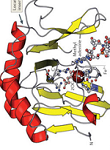|
|
|
The Role of TET Proteins During Development
|
|
|
|
|
|
|
|
|
|

|
|
|
|
Rita Khoueiry, and Kian Peng Koh.
|
|
|
|
Stem Cell Institute Leuven
|
|
KU Leuven Department of Development and Regeneration, Stem Cell Institute Leuven, 3000 Leuven, Belgium.
|
|
rita.khoueiry@kuleuven.be
|
|
|
|
|
|
|
|
|
|

|
|
In 2009, a new family of DNA modifying enzymes, the Tet-eleven translocation family was identified as 2-oxoglutarate (2-OG) and Fe(II)-dependent dioxygenases. This family of enzymes comprises three proteins TET1, TET2 and TET3 that share a carboxyl-terminal core catalytic domain consisting of a conserved cysteine-rich domain, a double stranded β-helix domain and binding sites for the cofactors Fe(II) and 2-oxoglutarate. At their amino-terminal region, TET1 and TET3 have a CXXC DNA-binding domain. Interestingly, during evolution, the segment encoding the CXXC domain of TET2 was separated from the region encoding the catalytic domain and is now encoded separately by a neighboring gene, IDAX (also called CXXC4).
|
|
|
|
|
|
|
|

|
|